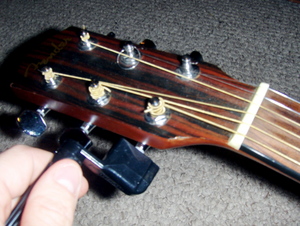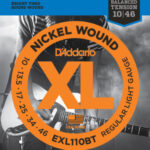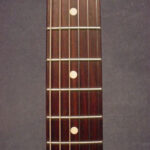It may surprise some people to know that guitar strings do not actually make any noise. The sound they seem to make comes from the resonating of the body and surfaces of the instrument to the vibrations created by the string. The second surprise, for at least some of you, may be that the older style strings (unlike many older style instruments) are not the best sounding or the best choice if you care about the final sound of your instrument and what it feels like to play it. I recently discovered Elixir Nanowebs when I bought a new guitar (a Taylor 355 12-string) that came with them installed from the factory. At first, I was suspicious and looked at them somewhat askance – wondering what kind of deal Taylor Guitars had cut with W.L. Gore & Associates, the makers of Elixir strings. Then, I picked up and played the guitar. Smooth and easy. Smoother and easier than I ever would have imagined possible – especially on a 12-string with its wider neck and twice as many strings to fret.
Next, I decided to give a set of these a try on my primary 6-string, a Martin HD28. I had never considered using anything but Martin SP strings on it since the day I brought it home. Bot, lo and behold! … these Elixer Nanowebs (Custom Light Gauge – .28 -1.32mm) not only sounded rich, smooth and mellow on the Martin but were actually smoother and easier on my fretting fingers than the SPs I had been using for years. I proceeded to put them on several other guitars and was consistently pleased with the result. This is about better living through chemistry, physics and a real understanding of both acoustics and instrument design and construction. The Nanoweb coating on the strings not only makes them smoother and easier on the fingers, but protects the strings from the inevitable skin and body oil deposits that result whenever a guitar is played and contribute to the corrosion of the string. Thus, these strings seem to be lasting and staying “fresh” a good deal longer. In fact, I estimate that I am getting 3 -5 times the use out of each set than I was accustomed to getting from top quality strings of other types. I will not try to guarantee that much change for everyone – there are too many variables. How often and how you play, for example. But, I do feel that anyone would notice an appreciable difference. The construction of the strings is pretty simple to understand. On each string, a microscopically thin, advanced polymer tube is used to surround it without making any contact with the critical area between the windings where the “critical zone of tone” is found and each sought perfect note is formed.
When I began playing acoustic guitar (in 1967), the best strings I knew about were called “Silk and Steels. They were the highest incarnation of the idea at that time. Winding fibers of silk into the metals of the wound (heavier) strings, increased their smoothness and extended their life. Later, bronze strings were the rage. Still later – Phosphor Bronze wounds were considered state-of-the-art. But now they, too, are old hat. Available in both Polyweb and Nanoweb coatings (the Nanowebs being the ulta-thin coated ones that I am using, the Polywebs being a bit more heavily coated: the difference being in your preference for sound and feel), either will give you a pleasant surprise. Even if you decide you don’t care for them, giving them a try is clearly worth the price of one set of strings. A try truly worth trying.





